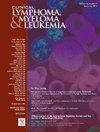原发性中枢神经系统淋巴瘤的降级诱导疗法和基于硫替派/丁砜的自体干细胞移植。
IF 2.7
4区 医学
Q2 HEMATOLOGY
引用次数: 0
摘要
背景:基于硫替帕的自体干细胞移植(ASCT)可提高原发性中枢神经系统淋巴瘤(PCNSL)的生存率,但在常用的强化诱导方案下,约30%的患者无法接受ASCT。方法:这项基于人群的回顾性研究纳入了2011年至2022年在加拿大艾伯塔省计划进行ASCT的≥18岁PCNSL患者。2018年,为了降低毒性并加速ASCT,一种降低强度的诱导方案被进一步简化,该方案在巩固硫替帕-布磺胺调节之前,通过合并利妥昔单抗、丙卡嗪和仅2剂量高剂量甲氨蝶呤和1周期高剂量阿糖胞苷来降低毒性并加速ASCT。采用Kaplan-Meier法测定无进展生存期(PFS)和总生存期(OS)。结果:71例患者中位年龄为58岁(26 ~ 72岁),56例(79%)完成ASCT,其中60 ~ 60岁患者的移植率在诱导治疗缩短后提高了30%。中位随访时间为3.9年,所有患者的4年PFS和OS分别为69% (95% CI 56%-79%)和80% (95% CI 67%-88%), ASCT受体的4年PFS和OS分别为75% (95% CI 57%-86%)和85% (95% CI 68%-93%)。在诱导期间有1例治疗相关死亡,ASCT后无一例死亡,包括17例年龄在60岁至60岁之间的移植患者。结论:缩短诱导方案后采用硫替帕-布苏凡为基础的ASCT,移植率高,复发风险低,治疗相关死亡率低,为PCNSL提供了一种有效的治疗策略。本文章由计算机程序翻译,如有差异,请以英文原文为准。
De-escalated Induction Therapy and Thiotepa/Busulfan-based Autologous Stem Cell Transplantation for Primary Central Nervous System Lymphoma
Background
Thiotepa-based autologous stem cell transplantation (ASCT) improves survival in primary central nervous system lymphoma (PCNSL), but > 30% of patients are unable to undergo ASCT following commonly used intensive induction regimens.
Methods
This retrospective population-based study included consecutive patients ≥ 18 years old with PCNSL who were intended for ASCT in Alberta, Canada between 2011 and 2022. A reduced-intensity induction protocol was further abbreviated in 2018 to decrease toxicity and expediate ASCT by incorporating rituximab, procarbazine, and only 2 doses of high-dose methotrexate and 1 cycle of high-dose cytarabine before consolidation with thiotepa-busulfan conditioning. Progression-free survival (PFS) and overall survival (OS) were determined using the Kaplan–Meier method.
Results
Among 71 patients with median age 58 years (range 26-72), ASCT was completed in 56 (79%), with the transplantation rate among patients > 60 years old increasing by 30% following the abbreviation of induction therapy. With median follow-up time 3.9 years, 4-year PFS and OS were 69% (95% CI 56%-79%) and 80% (95% CI 67%-88%) for all patients and 75% (95% CI 57%-86%) and 85% (95% CI 68%-93%) for ASCT recipients, respectively. There was 1 death due to treatment-related mortality during induction and none after ASCT, including among 17 transplanted patients > 60 years old.
Conclusion
An abbreviated induction regimen followed by thiotepa-busulfan-based ASCT achieves high transplantation rates with low risks of relapse and treatment-related mortality, thereby providing an effective treatment strategy for PCNSL.
求助全文
通过发布文献求助,成功后即可免费获取论文全文。
去求助
来源期刊

Clinical Lymphoma, Myeloma & Leukemia
ONCOLOGY-HEMATOLOGY
CiteScore
2.70
自引率
3.70%
发文量
1606
审稿时长
26 days
期刊介绍:
Clinical Lymphoma, Myeloma & Leukemia is a peer-reviewed monthly journal that publishes original articles describing various aspects of clinical and translational research of lymphoma, myeloma and leukemia. Clinical Lymphoma, Myeloma & Leukemia is devoted to articles on detection, diagnosis, prevention, and treatment of lymphoma, myeloma, leukemia and related disorders including macroglobulinemia, amyloidosis, and plasma-cell dyscrasias. The main emphasis is on recent scientific developments in all areas related to lymphoma, myeloma and leukemia. Specific areas of interest include clinical research and mechanistic approaches; drug sensitivity and resistance; gene and antisense therapy; pathology, markers, and prognostic indicators; chemoprevention strategies; multimodality therapy; and integration of various approaches.
 求助内容:
求助内容: 应助结果提醒方式:
应助结果提醒方式:


